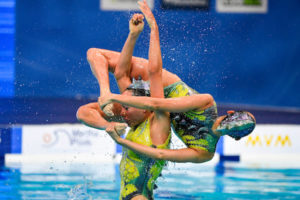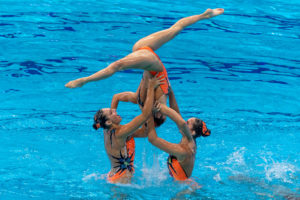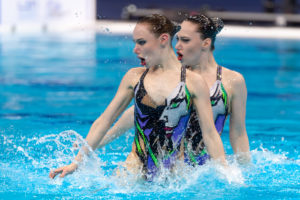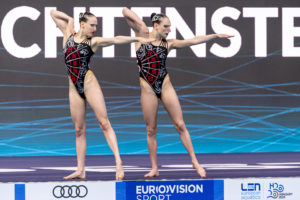After three postponements and a seemingly endless wait, the Olympic Games Qualification Tournament is finally here. 26 countries will face off and compete for one of the few remaining Olympic quotas in the team or duet events. It all starts in one week in Barcelona, and will be held in conjunction with the World Series Super Final.
What’s at Stake
First, let’s check in with the Olympic qualification procedures. In total, 10 teams and 22 duets will compete at the 2020 Tokyo Olympic Games. All countries in the team events will automatically have a duet in the meet as well.
Right now, seven teams and 12 duets have formally earned a quota through various competitions. The teams are Australia, Canada, China, Egypt, Japan, Russia (Russian Olympic Committee), and Ukraine. The duets are Australia, Canada, China, Egypt, Japan, Kazakhstan, Mexico, New Zealand, Russia (Russian Olympic Committee), South Africa, Spain, and Ukraine.
However per FINA, New Zealand did not take its quota. There are no other country representing Oceania in artistic swimming that is not yet qualified. Thus, that quota should be redistributed using the results of these Olympic qualifiers.
Consequently, this meet will ultimately determine the final three teams and 11 duets that will head to Japan this summer. The duets from the final three qualifying teams will automatically earn a berth to Tokyo. The remaining eight duet quotas will be won in the subsequent duet competition. The rankings, and quota attribution, for both events will be based on the combined technical and free scores.
Nonetheless, the duet qualification process is not as straightforward as it seems, and does get a bit confusing for the European quota. The rules read that “the best ranked duets in each of the five continental championships will obtain a quota place. Should the highest ranked duet already be qualified through the team, the next highest ranked duet from the Continental qualifying event will obtain a quota.”
Originally, Ukraine had qualified only its duet at the European Cup (EC) back in May 2019. A few months later however, the whole team qualified via the FINA World Championships in July. Its duet quota thus fell under the team’s. As a result, the EC duet spot was passed down to Spain, which was the next eligible country in the combined rankings.
Now, Spain is one of the favorites to qualify as a team. So, much like what happened with Ukraine, its duet would fall under the team quota. Looking at the combined European Cup results, the next nation in line would be Italy, which is also a big contender to move on to Tokyo. So theoretically if both Spain and Italy make it as a team, that EC quota would again be passed down to the next country: Great Britain. The British pair will obviously still be in Barcelona, but its fate is closely linked to Spain’s. In the end, it actually may not need to compete in the Qualification Tournament, again depending on which teams make it.
Team Qualification
The meet will start right away with the adrenaline-pumping team events on June 10 and 11. There will be no preliminary round, so each country essentially gets the one and only swim per event. No mistakes allowed.
Seven nations will compete: France, Greece, Hungary, Italy, South Korea, Spain, and the U.S. Only the top three teams with the highest combined scores will advance to Tokyo.

Looking at track records, Spain and Italy are favorites to grab two quotas here. The Spanish recently unveiled two new choreographies at the European Championships. Their highly anticipated technical routine, mixing flamenco and Japanese sign language, scored 89.7700. In free, they earned 91.2333 for their “Darwin’s Evolution Theory” routine. In terms of roster, the only anticipated change from Budapest is that Ona Carbonell should also swim in the free routine.
Italy had originally planned to be in Budapest, but bouts of Covid-19 and short-term injuries within the team hampered those plans. As a result, it has not competed since 2019 Worlds. That said, the core of the team has not changed since.
The Italians will actually be the most experienced of the field as four returning Olympians will swim in Barcelona. Besides, the country is the only one at these qualifiers to have had a team at the 2016 Rio Games.
Overall, the two Mediterranean nations have been neck and neck all quad. They placed fifth and sixth in both team events at the last World Championships in 2019 in South Korea. There, Italy still had the edge in the technical team — 91.0411 to 90.2506. But Spain’s 91.4000 in free placed them only 0.2000 points behind.
Barring a disaster, both countries are well positioned to move through to Tokyo. In the end, it will certainly be interesting to see these two match-up again after two years.
The fight for the final spot will be brutal, intense, and exciting. On paper, it should come down to France, Greece and the U.S.
The last time all three nations competed against one another was at the 2019 World Championships. In Gwangju, Greece had outscored the other two in both team events. While it was ahead of France by about a point in free, it only managed to stay ahead in tech by 0.4320 points. Comparatively, the U.S. was still a couple of points behind back then.
Of course, a lot has changed since. These three teams have a lot in store for us at this competition. The global overview is below, but extra content on all of them will get published over the next few days. Stay tuned for that!

Since Gwangju, the Greek have kept relatively quiet. They did recently compete in free combination at the European Championships, their first meet in two years. There, they won a silver medal with a score of 89.1000. Meanwhile, veteran Evangelia Platanioti also snatched two medals and career-high scores in solos.
Former Spanish national team coaches Anna Tarrés and Bet Fernandez have been collaborating with the country since the fall of 2019. They have built a brand new free team choreography around the retelling of the Greek myth of Icarus. The young squad is expected to showcase a new technical programme as well.
France looked ready to challenge the Greek team after 2019. Everything seemed to indicate that the final team spot for Tokyo would likely be between these two European countries. However, all bets were off after the Americans outscored the French by 0.5666 points in free at the 2020 French Open. France did nonetheless stay ahead in the technical event. Obviously from that point on, the U.S. also very much became a realistic contender for the Games.
Much like Greece and Italy, France has kept a low profile, and has not competed since that French Open. It has worked extensively with choreographer Stephan Miermont on improving and changing its “Zombies” free team routine. The French will also reveal a brand new technical programme.
On the other hand, the U.S. team has already competed this season in both virtual World Series legs. The Americans have kept their signature “Robots” routine, but have made significant changes to it since the French Open. They just received 89.0667 at their latest outing last week, solidifying their three-points improvement since 2019. Like their opponents, the Americans will unveil a brand new technical routine in Barcelona.
Ultimately and with combined scores, it will likely come down to a slim margin between these three. It’s been nearly two years since they faced off. With no clear idea on how they all look overall, it’s impossible to even pick one that could potentially emerge as the favorite. Will the different choreographic choices pay off? Which strategy between staying hidden or showing up will ultimately lead to the greatest reward? Which team will handle best the immense pressure it is about to experience?
Realistically, it would take all of five of these nations to falter for South Korea and Hungary to make a run for Tokyo. That said, it however will undoubtedly be an invaluable experience for both squads, who are quite young and looking towards the future.
The Hungarians, all but one still juniors, have already gotten some experience under their belt this year. They appeared at the second World Series and at the European Championships, both held in Budapest. The Koreans also recently competed at the second virtual World Series. They received a 78.9421 in technical team, a two and a half points improvement since Gwangju, but did not show their free routine.
No matter the outcome, these team events will certainly be one of the greatest showdowns of the season.
Duet Qualification
Again, all three duets from the newly qualified teams will earn an automatic ticket to Tokyo. Like in team, the remaining eight duet spots will be determined using the combined technical and free scores.
Whatever happens to the team, Spain‘s duet is already qualified. It will thus not compete in the Qualification Tournament portion of this competition.
25 nations are entered in the duet events for now: Argentina, Austria, Belarus, Brazil, Colombia, Czech Republic, France, Great Britain, Germany, Greece, Hungary, Israel, Italy, Liechtenstein, Netherlands, Portugal, San Marino, Serbia, Singapore, Slovakia, South Korea, Sweden, Switzerland, Turkey and the U.S.
Depending on the team results and how some of the quotas get reallocated, two or three countries will ultimately not be in the duet lineups once these start.
Out of the nations in the run for a team spot, two of France, Italy, Greece and the U.S. will need their duets to swim on June 12 and 13 to qualify.
The U.S. duet of Anita Alvarez and Lindi Schroeder is the only pair that’s competed this season. The two have a new technical programme set to a mix of “Für Elise” interpretations. In free, they continued swimming their Billie Eilish choreography that was already shown in Paris in 2020.
France will rely on Charlotte and Laura Tremble, who last competed at the 2020 French Open. The twins are expected to showcase their “Amazon” free duet, which helped them to a career-high of 88.5667 in 2019. They will nonetheless unveil a new technical programme, portraying the emotional and heartfelt topic of violence against women.
Both Greece and Italy will count on their 2016 Olympic pairs in this event. However, neither has competed since the Gwangju World Championships. Since they have been intensely focusing on the team qualification, the Greek Evangelia Platanioti and Evangelia Papazoglou have kept the same routines as in 2019.
The Italians Linda Cerruti and Costanza Ferro may have been briefly hindered by the former’s ankle sprain a few weeks ago. Nevertheless, they again may not necessarily have to compete for a quota if the full squad qualifies as expected.
While all four of them should qualify in some way, it might however be a tough ordeal for them to make the podium. Some other nations have had the luxury of solely working on their duet routines, and their improvement has been stratospheric.
As seen at the recent European Championships, these new pairs are shaking up the status quo and challenging the traditional powerhouses. It will be thrilling to see here how they fare next to some of the more experienced ones, and what these duet rankings look like now with mostly everyone in the same competition.
2016 Olympians Anna Maria and Eirini Maria Alexandri from Austria are clear favorites to advance to Tokyo. On top of that, they could also very well win the duet competition here. The sisters are just coming off two historical bronze medals in Budapest, with massive scores of 89.4592 in tech and 90.8667 in free.
These marks are comfortably above the previous top scores of France, Greece and the U.S., and also very well into Italy’s usual scoring range.

Moreover, Vasilina Khandoshka and Daria Kulagina could end up on the podium here as well, obviously on top of qualifying Belarus to Tokyo. The two came out with a bang at Europeans, scoring into the 88s in both events, and improving by five to seven points since 2019.
Similarly, the Dutch twins Bregje and Noortje de Brouwer were astounding, moving past Spain in the rankings and also reaching new career-high scores in the 87-88s.
Both of these pairs are looking for a first-time appearance at the Games. A simple repeat of their European swims should comfortably lead them there.
So, these are already five duets in a solid position to make it to Tokyo, out of eight available quotas. In the low-probability event that Spain doesn’t qualify a team, then Great Britain will have to look for a quota through this route. That shouldn’t be a problem, if necessary. Kate Shortman and Isabelle Thorpe also showed great progress in Budapest, receiving a 84.9244 for their new “Vampires” technical routine, and 85.8000 in free.
Israel is another pair that cannot be overlooked. Eden Blecher and Shelly Bobritsky have had a stellar season so far, improving their tech score by four points in both tech and free since 2019, and with two new choreographies. While they may previously have been on the bubble for a spot, these two have now positioned themselves as near-locks for the Games.
Finally, there are not enough words to describe how insane the fight will be for the (likely) final two spots.
At the European Championships, it seemed it could potentially come down to Liechtenstein, Switzerland and Germany.

Liechtenstein may have a foot in the door thanks to its free routine, but not by much. In Budapest, Lara Mechnig and Marluce Schierscher comfortably outscored the other two by one or two points, respectively. They even reached a new career-best of 84.4000 in the preliminary round.
However in the technical event, all three are neck and neck. They actually finished within 0.5259 points of each other. Switzerland’s Vivienne Koch and Joelle Peschl had the lead over the other two with a 82.7963. Germany‘s Marlene Bojer and Michelle Zimmer wedged themselves right in the middle, only 0.1464 behind the Swiss. More recently in the virtual World Series, Germany again finished ahead of Liechtenstein, 80.7454 to 79.4879.
Taking each pair’s season highs to get an idea of a “potential best” combined score, Liechtenstein is at 166.6704, Switzerland at 166.0630 and Germany at 165.3499. Clearly, there is absolutely no room for error, and each must be at its absolute peak in Barcelona if it wants to qualify.
Colombia and Brazil are also very much part of the conversation for one of these final quotas. They also will undoubtedly add a lot of pressure on those European nations above.
Both last competed at the 2021 South American Championships back in March. 2016 Olympians Estefania Alvarez and Monica Arango did have the edge back then with a combined score of 162.4857, over 162.0525 from Brazil’s Laura Miccuci and Luisa Borges.
Like in the team event, a very slim margin will end up making the difference as to who goes to Tokyo or not.
Of course, there are nearly a dozen more pairs on the bubble, waiting for one of the above to make a mistake to squeeze in there and grab a ticket to the Games. Argentina, Czech Republic, Portugal, San Marino, Serbia, Singapore, Slovakia and South Korea are all hovering in the mid- to high-70s in both events, ready to upset. In addition, Turkey‘s duet will make its season debut in this competition as well, and will look to position itself as another contender. Overall, the duet competition will undoubtedly deliver high-caliber performances and an exciting outcome.
All information related to the competition can be found here.
ARTICLE BY CHRISTINA MARMET
Cover photo: Giorgio Scala / Deepbluemedia
If you’ve enjoyed our coverage, please consider donating to Inside Synchro! Any amount helps us run the site and travel costs to cover meets during the season.

